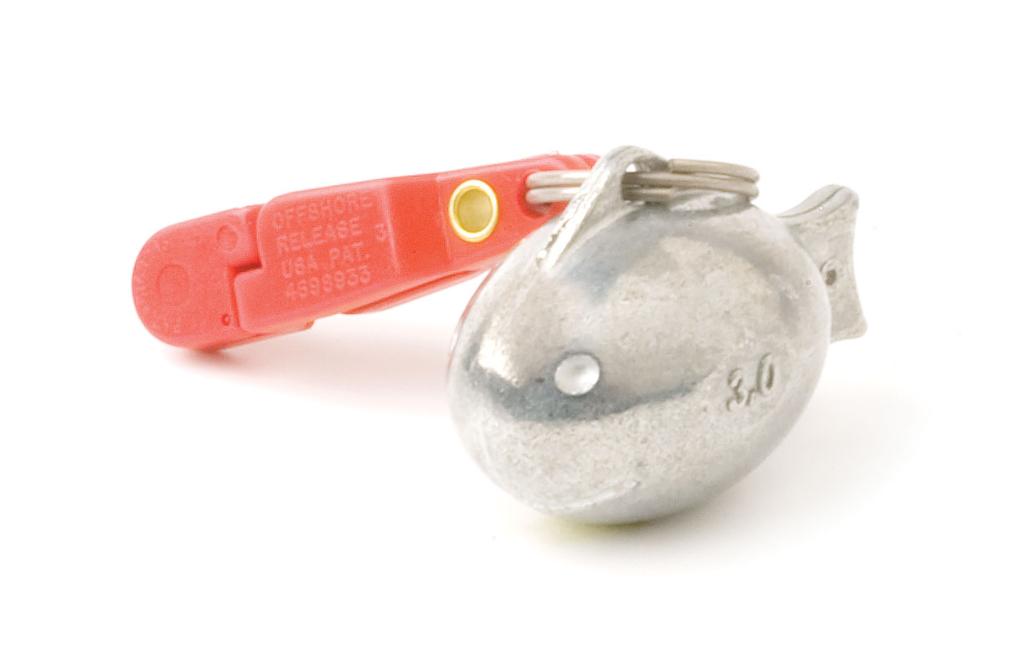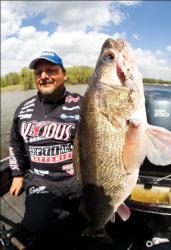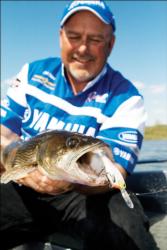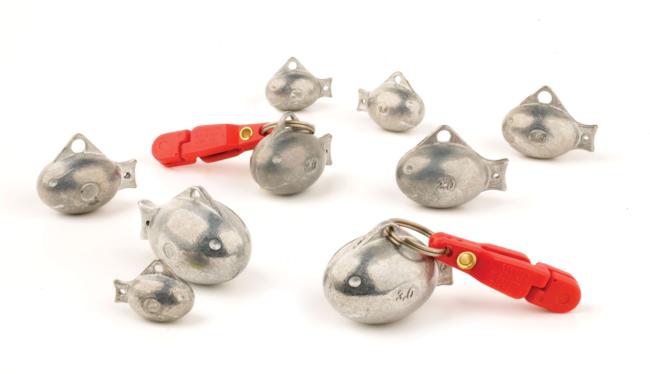It’s a snap
Heavy snap weights and superline offer an alternative to lead core

————————————–
Editor’s note: This is just one article from a recent issue of FLW Outdoors Magazine, which publishes both a Bass Edition and a Walleye Edition. To learn more about the magazine and how to subscribe, click here.
————————————–
Four crankbaits wobbling on the ends of four long lengths of lead core are effective at seining the depths for deep walleyes. That is, until one of the crankbaits snags a leaf, stick or some other assorted debris. Then it runs sideways. With the other lines nearby crisscrossing in the same water depths, it doesn’t take a fishing genius to know a tangled disaster is in the making. Time to crank in that line – all 150 feet of it.
Open-water trollers negate many of the tangling problems with planer boards, of course. Planer boards serve a variety of other purposes, but keeping lines spread out and under control while fishing suspended walleyes is job one.
Deep-water river trollers (and really, trollers who are using lead core anywhere) can accomplish the same purpose by swapping a few of their lead-core rods for setups with superline and heavy snap weights. This trick is really nothing new, but it is not commonly seen in conjunction or as a substitute for lead-core trolling.
Yet, some pros, such as Pat Neu of Forestville, Wis., and Dan Stier of Mina, S.D., are rapidly learning the benefits of running the two in tandem, or even abandoning lead core altogether. Dealing with a tangled mess of lead core, lead lines and crankbaits, particularly with cold hands during a big-river tournament, is likely to encourage anyone to search for a better way.
“In water that lends itself to use with lead core, you often have four lines running alongside one another within a 25-foot area,” Neu said. “That’s just a recipe for disaster if one of them picks up some debris. So I started looking for rigs that would still get lures down to the fish but would spread them out both horizontally and vertically.
“I remembered some tricks we began using on Lake Michigan with snap weights and superlines to get dodgers and flashers down to salmon in the 40- to 60-foot depth range. This was about 10 years ago when the lake began clearing up, and you had to fish deep because the salmon were being spooked by the boats overhead.”
Snap-weight rigs can still be used in conjunction with two lead-core lines, offering similar amounts of  coverage without all the tangling hassles. Plus, the weights have the added benefit of collecting surface debris that gathers on the line before it can reach the crankbait. That is not possible with lead core – yet another advantage of this system that Stier learned from a veteran South Dakota angler several years ago.
coverage without all the tangling hassles. Plus, the weights have the added benefit of collecting surface debris that gathers on the line before it can reach the crankbait. That is not possible with lead core – yet another advantage of this system that Stier learned from a veteran South Dakota angler several years ago.
“He always made fun of lead-core trollers,” Stier said. “He didn’t use anything other than snaps for contour-trolling crankbaits. I’ve learned that by using snap weights, you can be in the strike zone longer, adjust quickly by reeling up or releasing line, and land fish or retrieve baits in about a third of the time that you can with lead core. Plus, because you’re using braided line, you can see the vibration of your crankbait through your rod tip. That’s critical, especially in a river system where you have a lot of debris – and it’s not always easy to see with lead core. If you pick up trash and the bait stops wobbling, it’s instantly ineffective.”
Ease of use, tangle-free and capable of reaching the depths – you can’t ask for much more from a trolling system to chase the contours of deep water.
Simple set
The technique is deceptively simple to fish.
“I’ve fished with people this way, and many of them have asked, `Why haven’t I been doing this all along?'” Neu said.
Some basic crankbait trolling knowledge and the ability to read a depth finder are required. Neu has found at 1.8 to 2 mph, the speeds he typically runs crankbaits, the depth he wants to hit with his crankbaits will closely match the length of line from the rod to the snap weight, given an 8-ounce weight, 30-foot lead, diving crankbait and 14/6 superline.
“Basically, you let out 30 feet of line on your line counter and clip on the weight,” Neu said. “Then, reset your reel and let out another length of line that corresponds to the depth you’re fishing – 25 feet of line for 25 feet of water, in other words. Then, put it in the rod holder and wait for a strike. It’s that simple.”
Stier’s setup is virtually identical, although he allows for a 50-foot lead (still trolling at approximately 2 mph).
“Fifty feet of line will usually provide about half of any crankbait’s diving depth,” he said. “If you have a bait that dives to around 12 feet or so, 50 feet is often about right.”
Stier has used this technique in water as shallow as 7 feet and as deep as 70 feet. He sticks with 8-ounce weights regardless.
Experiment a bit with the lead length you prefer. If you use a slightly heavier or lighter sinker, or if you have a favorite crankbait that runs a little shallower or digs a little deeper, some adjustments may be in order. These numbers are simply good starting points. Also, it is important to note the weight isn’t dragging along bottom. Rather, it hovers above, with the line at roughly a 45-degree angle in the water column. The crankbait actually dives and runs below it.
Both Neu and Stier often run two lead-core lines and two snap-weight lines (where legal, of course). The lead-core rods are typically run on the corners of the boat, while the snap weights are fished on the inside, directly out the back of the boat. This reduces, or even eliminates, the chances of them crossing one another.

Simple equipment
Neu uses an 8 1/2- to 10-foot lead-core rod for this presentation. He likes a rod with a stout backbone but with a light tip so he can tell when the lure hits bottom and when it picks up debris.
Stier varies his rod lengths depending on where they are positioned in the boat. Outside rods are generally 10 to 12 feet long. Inside rods might be as short as 6 feet.
Neu uses Off Shore Tackle snap weights. The typical size is 8 ounces as mentioned, but 6-ouncers are sometimes used as well, particularly when fishing shallow water. Similar to a planer board, these weights are attached to the line with an OR16 Snap Weight Clip that has a tiny protrusion through the center of the pad. The protruding stud on the OR16 clip keeps the clip from pulling off the line even with an 8-ounce weight attached.
Crankbait choices run the gamut, but something with a fair amount of wobble is best. Stier likes Salmo Hornets and Rapala Shad Raps. Neu often uses Reef Runners and SPRO MadEye Shads.
“You can really see them working in the rod tip, and it’s easy to tell when they pick up sticks and stuff,” Neu said. “Diving baits will pull down and run under the snap weight, but stick baits need longer leads to  run under the ball. That’s important to note. Also, if you’re using a smaller shallower-running bait, like when you’re fishing early in the season, you might be able to use a shorter lead.”
run under the ball. That’s important to note. Also, if you’re using a smaller shallower-running bait, like when you’re fishing early in the season, you might be able to use a shorter lead.”
Simple execution
Pulling a sizeable crankbait in current with an 8-ounce weight attached to the line will keep the rod loaded up, but detecting a strike isn’t a problem.
“The instant you pick up debris, the rod tip stops vibrating so you don’t troll very long with a fouled lure,” Neu said. “There’s also no doubt when you get a strike. They just nail it. And because you have so much less line out, you spend a lot less time reeling them in. That’s important in a tournament.”
Keeping fish hooked up isn’t a problem. If you have a partner, he needs to be ready as the snap weight comes over the side of the boat. Unclipping it should be a fluid motion with one hand while the other hand keeps the lead taut. But with the current and the rod loaded from the weight and the fish, this isn’t too difficult.
“I was fishing like this at a PWT event in Mobridge, and it was easy to remove the weight and keep tension on the fish, even when I was by myself pre-fishing,” Neu said.
Stier uses his reel’s clicker when fishing with snap weights.
“I set the clicker, back the drag off until it clicks, and then tighten it slightly,” he said. “When a fish hits, you’ll often hear it before you see it. Don’t get in a hurry. Lots of guys want to pick the rod up and immediately begin reeling. But the current and the forward motion of the boat will cause that fish to rise right to the surface most of the time. I just pick up my rod and wait until the fish is up. When the clicker stops, I tighten the drag just a bit and reel it in.”
Many fishing innovations and techniques have been created because of certain shortcomings or general discontent with other methods, but that doesn’t mean the other methods don’t still work and don’t still have their place. Lead-core trolling is a time-honored art, but it does take some time to master, and maintaining a spread of lead-core lines in water with heavy debris can be challenging.
Snap weights, superlines and crankbaits provide a viable, easy-to-use alternative for deep-contour trolling. And using them in conjunction with lead-core lines is still an option. Then again, once you try the snap-weight system for yourself, deploying them with lead core might not be an option – your lead-core reels could be gathering dust in the garage.

Open-water snap weights
When you realize the tangle-free advantages that trolling snap weights and crankbaits can provide in a river system, it’s easy to think of them primarily as a substitute for lead-core trolling in current. But the system has other uses as well, including targeting suspended fish in deep lakes and reservoirs.
Pro Pat Neu of Forestville, Wis., often uses his 8-ounce snap-weight system when fishing for walleyes holding deeper than 25 feet in slack water.
“At that point, you just can’t get a big-billed bait down there to them on (Berkley) Fireline,” he said. “I like using snap weights when I need to quickly present a vertical presentation, rather than the horizontal presentation of planer boards. However, the fish do need to be far enough off the bottom to keep from dragging the baits.”
Neu likens fishing snap weights in open water to fishing a downrigger. As when trolling the system in current, he simply divides the water column. If he marks fish at 30 feet over 50 feet of water, he’ll release 30 feet of line, attach his snap weight, reset his line counter and release another 30 to 35 feet of line. His crankbait will be within a few feet of the fish, but it also allows for rapid adjustment.
“If I’m trolling along this way and suddenly mark a big fish that’s just 5 feet off bottom (45 feet down), I can release more line so there is 45 feet out and, bam, the bait will pass close enough to trigger a strike,” Neu said. “I can also reel in some line if I spot a fish higher in the water column.
“This is just a fast, efficient way of getting crankbaits down to deep-water fish. It’s much faster and easier to adjust than lead core, and an 8-ounce weight doesn’t disturb the water column (and spook fish) much at all.”